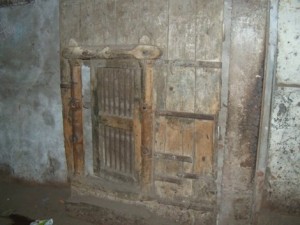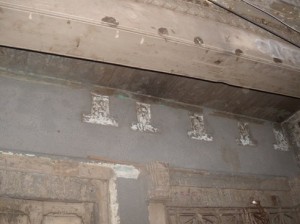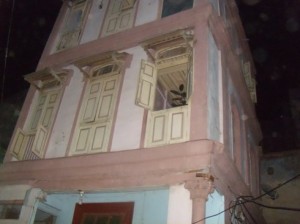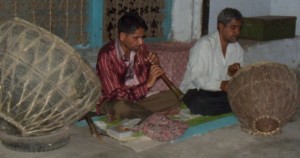
There’s more to Ahmedabad than meets the eye. Look beyond the garbage, the everybody-has-their-own-rules traffic, and the endless stalls of “egg” (yes, since most Gujarati’s are egg-itarians but don’t cook eggs at home, the humble egg is elevated to a specialty item here in Ahmedabad), and you’ll find a city rich in history and culture. Though that only becomes apparent when you go out of your way to take advantage of offerings like the Mangaldas ni Haveli’s (also known as The House of Mangaldas) walking tours. Or head 20 kilometers out of the city to Adalaj ni Vav. Or even make the effort to head to the corner of town that houses the Gandhi Ashram.
After spending many hours online (on deficient Gujarat Tourism “official” websites) trying to figure out “how” ( yes, there’s tons of websites on “what” to do but not too much about “how” to go about doing it) to visit Ahmedabad’s touristy options, I chanced upon Mangaldas ni Haveli’s heritage walk information. Since they answered the phone when I called and gave me a confident answer that the tour happens every night ( from November-March only), what time it happens ( at 9:30pm ) and the how it pans out ( you gather at Mangaldas ni Haveli at 9:30pm and are taken by their shuttle to the starting point),my mind was made up in an instant.
So Mangaldas ni Haveli is located right across Sidi Saiyad Jali at Lal Darwaja. Sidi Saiyad Jali is a mosque, a landmark in itself, which most autodrivers know off. In case you’re early, you can check out their souvenirs store. ( I picked up a copy of India Guide’s 101 ways to experience Ahmedabad for myself; and Bhojan no Anando which is their in-house restaurant cookbook for a friend.) Here’s where you pay Rs. 200 and are given a token (advice: keep it safely. You will be asked for it shortly). A shuttle van then takes you a short 5-7 minute drive away through Biscuit Galli (Biscuit lane) and a few other such lanes to another Mangaldas ni Haveli. A much smaller version of the main one opposite the mosque, this one used to be a restaurant too (which the Ahmedabad Municipality closed down because of the traffic snarls it was causing in the narrow lanes); but now serves as the starting point for their night walk. Put your details into the register, hand over your coupon to the manager here and walk up the three stories to get a glimpse into the lifestyles of the rich 200-400 years ago.
So, as I learnt from the guide, back then, houses had courtyards so that women could get a feel of being outside without having to leave home! In the winter, they could soak up the sun, in the monsoon, watch the rain … Mangaldas ni Haveli boasts of the family’s wealth through intricate carvings and their own well! Yep, in a world without Mercedes and fancy restaurants, having your own well meant that women didn’t need to go to the “common” well to collect water – which was obviously noticed by your friendly and nosy neighbours, thus classifying you as well-off.

The guide went on to explain that the basic layout of the city then consisted of pols and ols. Pols were residential complexes and ols were commercial complexes. Mangaldas ni Haveli is located in Lakha Patel ni Pol by the way. The walk then proceeds through a large number of pols and ols, which are one of the most ancient parts of the city. Each pol has a large gate above which stands the guards room. The gate consists of a smaller gate through which people need to bend over to enter. Apparently, this was done so that guards could easily chop off the head of the enemy if he tried to enter!
Mangaldas ni Haveli actually belonged to a rich business family from Bombay, the Dwivedis. After doing up the place, they lived there for 27 years. Post which, due to tragic circumstances, they were forced to sell the same and move back to Bombay. That’s how the Mangaldas’ came to own the same. Bought it for the lump sum of Rs. 27,000!
While the Mangaldas Haveli, in particular, is well-preserved, there are many havelis along the walk that are dilapidated and, are in all likelihood, on their last leg. Some have been locked up , some are embroiled in family disputes, some are being rented out, and still others are being held on to for sentimental (and need I mention, monetary) value. Whatever their status, all boast of some really intricate artwork! And as the guide kept mentioning, “Don’t be fooled by the outside. It may look like a small house from the outside; but there’re all big on the inside. Boasting of a courtyard, terrace, and minimum of 8 rooms!”


Not only beauty, the haveli’s have been well-built architecturally too. Acting as shock-absorbers, mini-stilts ensure that these are earthquake-resistant; and tons of windows ensure that they are always airy and well-lit when the sun was up.
Past the narrow lanes, the old havelis, Jain temples, bird feeders and Islamic monuments, you reach the vibrant food market at Manek Chowk. After a week of being in the city, I’ve gotten used to seeing Amdavadis pig out even at midnight. With the day being too hot to really venture out, late dinners or midnight snacks are clearly part of the culture here.
Last stop is the Raja no Hajiro – this is where the tomb of Sultan Ahmed Shah I (1411 – 1442), the founder of Ahmedabad lies. The tomb, with its perforated stone windows, stands just outside the east gate of the Jama Masjid. His son and grandson, who did not long survive him, also have their cenotaphs in this tomb. Women are not allowed into the central chamber. Across the street on a raised platform is the tomb of his queens – it’s now really a market and in very poor shape compared to Ahmed Shah’s tomb.

It is within the Raja’s complex that drummers signal the closing of the city gates from 11pm-11:15pm every night (and opening of the same every morning at 5:30am). This is a 600 year old ongoing tradition! Being drummers for this coveted role is a family tradition, it seems, with forefathers of the current drummers holding this position at one point of time. Today, they earn ~Rs. 7,000 a month for this role – with their salaries coming partly from the Ahmedabad Municipal Corporation and partly from the Mangaldas family.
There’s more stories about the lanes, the old havelis, the Jain temples, bird feeders and Islamic monuments which I have not captured here. Do the walk to be enlightened. It’s well-worth your time. I intentially chose the night walk from the available options, as I really wanted to avoid the strong afternoon sun ( yes, even in March the midday sun can really get to you in Ahmedabad.) And I’m glad that I made the right choice!
I was initially apprehensive about doing the walk at night. Primarily because I was concerned about how I would return back to my guesthouse at midnight – given that I am not familiar with the city, this being my first trip here that’s been more than a day long. But the hotel/restaurant has entrusted some autodrivers whom they have screened. Guests to the hotel/restaurant are recommended to use only these autos. In fact, I noticed even the women staff from the hotel/restaurant being dropped home by one of these drivers. So, I reached home safe and sound ( though I believe the autodriver did overcharge me. I paid Rs. 200 to get back to my guesthouse at Bodakdev; the same journey cost me Rs. 90 to get there.) But I didn’t want to ruin the night, so I paid up without a question. After all, it’s difficult to put a price on safety, isn’t it?

Just to add – I also was the only one on the tour. They do get a bunch a tourists (both Indian and foreign) every night – but clearly everybody else had plans this Saturday night. But not for a second did I feel unsafe. The guide was polite, patient and thoughtful. He even dropped me back to the hotel on his bike after the walk (which ends at Raja no Hajiro, 0.8 kms from the main hotel); we also grabbed a cup of tea at Lucky Tea as we waited for Deepakbhai ( the shuttle driver) to organize an auto for me.
Lucky originally started as a handcart under the shade of a neem tree, next to the company of several tombs. As business grew, so did the shop, eventually expanding around the graveyard and the tree. Though the owners do not know who lay in the tombs, they continue to offer incense, flowers and respect as they believe that these departed souls are the force behind’s Lucky’s success.
The guide, by the way, is Jamshed Turner. He is a freelancer who works for Mangaldas ni Haveli, amongst other tour companies. He also operates in the states of Madhya Pradesh, Rajasthan and Maharashtra.
Established in 2000, Give is the largest and most trusted giving platform in India. Our community of 2.6M+ donors have supported 2,800+ nonprofits, impacting 15M+ lives across India.
Discover more from
Subscribe to get the latest posts sent to your email.
